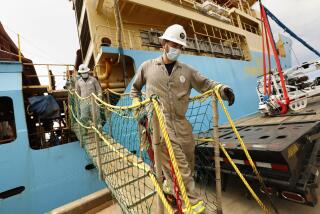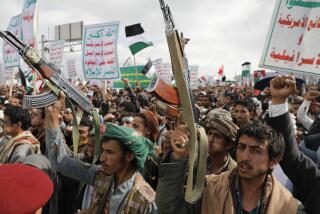Navy Faces a Terrorist Minefield in Persian Gulf
- Share via
MANAMA, Bahrain — As a possible conflict with Iraq approaches, the U.S. Navy has serious concerns that terrorists might try to strike ships in the Persian Gulf by mining the busy waterway.
Mines, said a veteran captain of a Navy minesweeper, are “the poor man’s weapon of choice”: cheap to buy, easy to deploy and difficult to detect. Finding mines in the Gulf is made more difficult by the high salinity and murkiness of the water.
Since the 1991 Persian Gulf War, during which two American warships were damaged by mines, the United States and other Western countries have sharply increased their efforts at mine detection in the region.
Four American anti-mine ships, a mine-hunting helicopter squadron and a group of Navy divers are assigned full time to the Persian Gulf to seek out the explosive devices. At the request of the U.S., the British Royal Navy in recent days deployed four mine-hunting ships to the region.
“It’s very hard to quantify the threat,” said Stephen Saunders, editor of Jane’s Fighting Ships. “The essence of mine warfare is not so much what you know but what you don’t. The discovery of one mine, however old and unsophisticated, poses problems.”
Although Iraqi President Saddam Hussein’s forces are known to have bottom, drifting and moored mines in their inventory, U.S. Navy officials are confident that the threat posed by his military has largely been thwarted.
The U.S. and its allies cleared more than 1,300 Iraqi mines from the area after the 1991 war, and the Iraqi navy no longer enjoys unfettered access to the Gulf.
Iran has mines purchased from China and Russia, as well as Russian-made submarines that can be used to place mines. But the Iranians have assisted the U.S. in recent months in blocking Iraqi oil tankers from violating a United Nations restriction on oil exports, and some civilian analysts believe they have also provided intelligence about mines.
The biggest mine threat is not posed by Iraq but by terrorists who want to make a political statement or kill Americans, according to Lt. Christopher Davis, spokesman for the Navy’s 5th Fleet, headquartered here in Bahrain, a tiny island nation in the Gulf.
The cheapness and portability of mines “makes some kind of harassment or limited offensive mining campaign a serious concern,” Davis said.
Mines can be purchased for a few hundred dollars and dumped overboard by boats no larger than the fishing vessels that are ubiquitous in the Gulf. The Tamil Tiger rebels in Sri Lanka have used mines to sink a number of that nation’s naval ships.
The U.S., Britain and Australia are continually monitoring the Gulf -- with ships, aircraft and satellites -- but no amount of surveillance is absolute, officials note.
“Mines are very ‘layable’ by small boats, and with all the traffic in the Persian Gulf all the time, it’s not hard to imagine a fishing boat carrying a mine or two,” said retired Rear Adm. John Pearson, chairman of the mine warfare division at the Naval Postgraduate School in Monterey, Calif.
“It’s not the kind of operation that would stick out like a sore thumb,” he said.
The British anti-mine warfare ships Bangor, Blyth, Sandown and Brocklesby -- accompanied by the supply ship Sir Bevidere -- are slated for “interoperability” training with U.S. and Saudi Arabian ships that are scouring the Gulf for mines, in anticipation of a large number of U.S. ships being sent to Kuwait carrying troops and supplies necessary for a land offensive against Iraq.
A century ago, the Royal Navy was the largest in the world. Now the fleet is barely one-tenth the size of the U.S. Navy. But mine hunting remains a British area of expertise, with skills honed by decades of standing guard against possible mining of Britain and the western European coastline by the Soviets.
The U.S. has two main classes of anti-mine warfare ships -- Osprey and Avenger -- both of which can detect and neutralize mines. The Osprey, known as a mine hunter, is used primarily in coastal waters; the larger Avenger is a minesweeper with greater detection capability.
Even with the possibility of “non-state actors,” which is the military euphemism for terrorists, attempting to lay mines in the Gulf, U.S. Navy officials responsible for hunting mines are confident that they and their allies -- the French, Dutch and Germans also have done minesweeping in the Gulf -- will repel any threat.
Unlike the Gulf War, which some analysts believe caught the U.S. Navy without a minesweeping plan, any new conflict would come after a decade of attention to the problem.
“We have a very large footprint in the Gulf these days,” said Capt. Terry Miller, mine warfare command operations officer at the Navy’s training center at Corpus Christi, Texas.
Still, detecting mines remains a tedious business even with new technology and improved training. A mine-hunting ship that moves at 4 knots -- just over 4 mph -- is considered speedy; sonar often cannot detect the difference between a bottom mine and a sunken refrigerator.
“Mine warfare is one of the most difficult, time-consuming, complicated, exacting and least understood areas of modern warfare,” said Cmdr. Steven Ritchie, former commanding officer of the Avenger-class minesweeper Scout.
“Finding a small, irregular shaped and sometimes nonmetallic mine is similar to finding the proverbial needle in a haystack,” he said.
Perry was recently on assignment in Manama.
More to Read
Sign up for Essential California
The most important California stories and recommendations in your inbox every morning.
You may occasionally receive promotional content from the Los Angeles Times.













